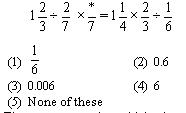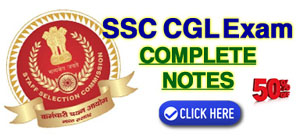(Model Paper) LIC AAO Exam (Quantitative Aptitude)

Life Insurance Corporation
Model Paper for LIC AAO Exam (Test – II: Quantitative Aptitude)
41. (2 + 2 ÷ 2) + (3 + 3 ÷ 3) × (4 + 4 ÷ 4)
(1) 23
(2) 8
(3) 6
(4) 35
(5) None of these
42.
43. 40.84 × 5.5 + 4.5 × 6.40 = ?
(1) 253.42
(2) 2613.76
(3) 243.12
(4) 1400.812
(5) None of these
44. 70 69 66 61 ?
(1) 56
(2) 54
(3) 57
(4) 53
(5) None of these
45.

(1) 12.6
(2) 11.8
(3) 14.2
(4) 13.8
(5) None of these
46.
(1) 49
(2) 9
(3) 7
(4) 16
(5) None of these
47.
48. 4633 1 + 73242 + 4563 – 8989 = ?
(1) 115447
(2) 124447
(3) 115147
(4) 115357
(5) None of these
49. 131 × 225 = ?
(1) 27725
(2) 29475
(3) 26475
(4) 29775
(5) None of these
50.

(1) 57
(2) 63
(3) 73
(4) 67
(5) None of these
51. By selling a table for Rs 350 instead of Rs. 400, loss per cent increases by 5%. The cost price of the table is
(1) Rs 1,050
(2) Rs 417.50
(3) Rs 435
(4) Rs 1,000
(5) None of these
52. At what rate per cent per annum will the simple interest on a sum of money be of the amount in 10 years?
(1) 4%
(2) 6%
(3) 5%
(4) 6 %
(5) None of these
53. The least multiple of 13 which on dividing by 4, 5, 6, 7 and 8 leaves remainder 2 in each case, is
(1) 2520
(2) 842
(3) 2522
(4) 840
(5) None of these
54. Find the value of * in the following:

55. The greatest number which when divides 989 and 1327 leaves remainders 5 and 7 respectively, is
(1) 8
(2) 16
(3) 24
(4) 32
(5) None of these
56. A certain amount of money is distributed among A, B and C. A gets and B gets of the whole amount. If C gets Rs 81, then B gets
(1) Rs 30
(2) Rs 36
(3) Rs 32
(4) Rs 40
(5) None of these
57. The least number that must be subtracted from 63520 to make the result a perfect square, is
(1) 16
(2) 20
(3) 24
(4) 30
(5) None of these
58. The ratio of the present ages of two brothers is 1 : 2 and 5 years back the ratio was 1:3. What will be the ratio of their ages after 5 years ?
(1) 1 : 4
(2) 2 : 3
(3) 3 : 5
(4) 5 : 6
(5) None of these
59. Divide Rs 7,500 among A, B and C such that A's share to B's share is in the ratio 5 : 2 and B's share to C's share is in the ratio 7 : 13. How much will B receive?
(1) Rs 1,400
(2) Rs 3,500
(3) Rs 2,600
(4) Rs 7,000
(5) None of these
60. The ratio of copper and zinc in brass is 13:7. How much zinc will be there in 100 kg of brass?
(1) 20 kg
(2) 55 kg
(3) 35 kg
(4) 40 kg
(5) None of these
61. Sum of three consecutive even integers is 54. Find the least among them.
(1) 18
(2) 15
(3) 14
(4) 16
(5) None of these
62. A TV and a VCR together cost Rs 35,000. If TV is times costlier than VCR, then the cost of VCR is
(1) Rs 12,000
(2) Rs 14,000
(3) Rs 13,000
(4) Rs 15,000
(5) None of these
63. If one-third of one-fourth of a number is 15, then three-tenths of the number is
(1) 35
(2) 36
(3) 45
(4) 54
(5) None of these
64. A milkman has 75 litres milk in one can and 45 litres in another. The maximum capacity of a container which can measure milk of either container exact number of times, is
(1) 1 litre
(2) 5 litres
(3) 15 litres
(4) 25 litres
(5) None of these
65. A student was asked to multiply a number by but he divided that number by . His result was 10 less than the correct answer. The number was
(1) 10
(2) 12
(3) 15
(4) 20
(5) None of these
66. A and B together have Rs 158, C has Rs 101 less than what A and B together have, and B has Rs 23 more than C. Then amount of A is
(1) Rs 80
(2) Rs 78
(3) Rs 57
(4) Rs 88
(5) None of these
67. Three solid metallic balls of radii 3 cm, 4 cm and 5 cm are melted and moulded into a single solid ball. The radius of the new ball is
(1) 2 cm
(2) 3 cm
(3) 4 cm
(4) 6 cm
(5) None of these
68. A car goes 10 metres in a second. Find its speed in km/hour.
(1) 40
(2) 32
(3) 48
(4) 36
(5) None of these
69. A 120 m long train takes 10 seconds to cross a man standing on a platform. What is the speed of the train?
(1) 12 m/sec
(2) 10 m/sec
(3) 15 m/sec
(4) 20 m/sec
(5) None of these
70. If cost price is Rs 80, overhead is Rs 20 and selling price is Rs 120, then the profit per cent is
(1) 20%
(2) 50%
(3) 40%
(4) 30%
(5) None of these
